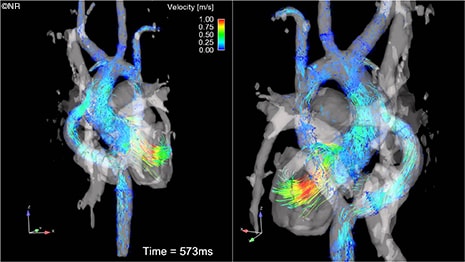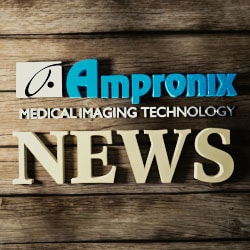4-D MR imaging offers new insight previously unavailable with other diagnostic tests
Orange County, CA - October 5th 2017 - For more than a decade Michael Markl, Ph. D., director of cardiovascular imaging research at Northwestern University, has been working to bring 4-D MR imaging to the medical field. Recently, the American Heart Association cited 4-D imaging in its journal Circulation: Cardiovascular Imaging, for its use in predicting stroke risk in atrial fibrillation patients. ‘Afib’ patients account for 30 percent of stroke cases every year.
With 4-D MR imaging, cardiologists are able to watch intricate blood flow unfold over time. “Compared to other MR tests, 4-D flow is very easy to perform. Other standard techniques often require multiple 2-D measurements to gain a complete picture,” explained Markl. Additionally, 4-D MR imaging offers new insight previously unavailable with other diagnostic tests. For example, information on time-resolved 3-D blood flow through all four cardiac chambers and valves is now obtainable through a single scan.
These 4-D MR images have received award winning recognition for not only usefulness, but vivid color and crisp definition in imagery. A graduate student working under Markl recently won top honors in an annual scientific imaging contest implementing this process.

Over the past two years significant steps have been taken to propel 4-D imaging into the mainstream. The first being, the adoption of a consensus statement regarding the clinical use of 4-D flow MR. A crucial step in the field in directing academic group studies. Second, software compatibility needed to reach the technological capability necessary for 4-D imaging. 4-D MR flow scans can generate up to 10,000 images. Thankfully new software developments have rendered this issue null and void. Markl is excited to uncover all the potential benefits of the 4-D system. "The strength of 4-D flow MR is its ability to help gain an understanding of complex situations," Markl told HCB News. "For example, in congenital heart disease that cannot- or can only incompletely- be assessed with other imaging modalities." He continued, “A lot of pieces are currently falling into place and I am very optimistic about the potential of the techniques to advance to a mainstream imaging test.”
To drive 4-D imaging even further, Markl explains that collaborative efforts across all disciplines, such as M.D. and Ph. D. joint work, is vital. However, he notes that an obstacle of this collaboration will stem from the recent presidential order restricting travel to the U.S. from certain countries. "My cardiovascular research group at Northwestern alone is composed of students, postdoc, and faculty from seven countries, among them Iran," said Markl. This hindrance is concerning regarding future research, but Makrl is determined to move forward and propagate 4-D imaging to professionals in the medical industry.
Contact Ampronix:

Email: info@ampronix.com
International Sales: +1 949-273-8000
Domestic Sales: 1800-400-7972 for US and Canada
Follow Us:
Share This Article:
View our Product Catalog Online Here
About Ampronix
Ampronix is a renowned authorized master distributor of the medical industry's top brands as well as a world class manufacturer of innovative technology. Since 1982, Ampronix has been dedicated to meeting the growing needs of the medical community with its extensive product knowledge, outstanding service, and state-of-the-art repair facility. Ampronix prides itself on its ability to offer tailored, one-stop solutions at a faster and more cost effective rate than other manufacturers. Ampronix is an ISO & ANSI/ESD certified facility. To learn more go here.

4-D MR imaging offers new insight previously unavailable with other diagnostic tests Orange County, CA – October 5th 2017 – For more than a decade Michael Markl, Ph. D., director of cardiovascular imaging research at Northwestern University, has been working to bring 4-D MR imaging to the medical field. Recently, the American Heart Association cited 4-D […]



